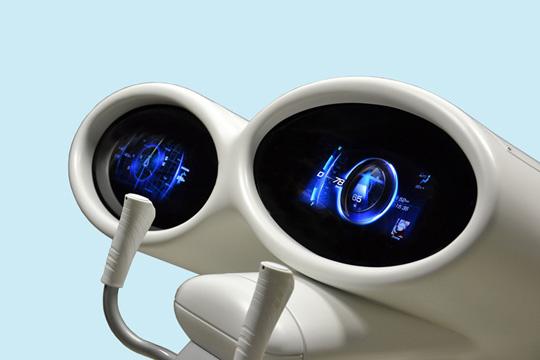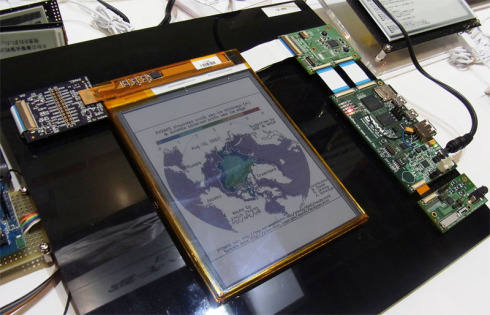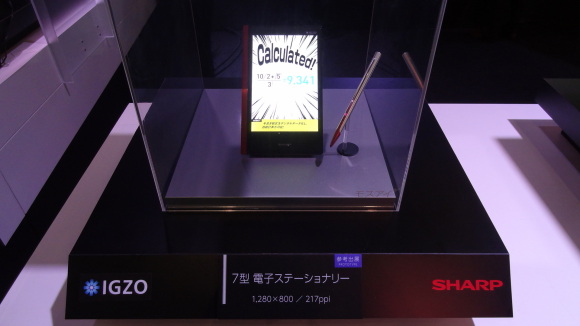Display Industry Technology News Roundup 5.3.2015

Image via Apple Watch
How does Apple's Force Touch enhance the touchscreen experience? "On March 9, Apple announced the Apple Watch and new MacBook at its Spring Forward event. The company also acclaimed its Force Touch (with Taptic Engine) as a new concept in these products. Apple previously seemed more interested in pressure-sensing technology, as it applied for a stylus use patent. However, tap-sensing replaced pressure-sensing. Tap-sensing is limited in pressure detection, and its sensing level is not as sophisticated as pressure-sensing technology. ...Force Touch is more of a marketing term than a specific technology. Apple will likely adopt the most appropriate tap-sensing technology depending on the product. For example, the company already indicated that touch screens are not suitable for clam-shell notebook form factors. Still, Apple will continue to improve its user interface. In addition to the new butterfly mechanism replacing the scissor-like keyboard, Force Touch replaces the diving board design to make its trackpad better." via ECN Magazine
Sharp may spin off LCD unit "Loss-making Japanese electronics maker Sharp Corp (6753.T) may spin off its LCD panel business and seek funding for it from the government-backed Innovation Network Corporation of Japan (INCJ), a source familiar with the plan said on Sunday. The Nikkei business daily earlier reported that the LCD unit, which supplies displays to smartphone and tablet manufacturers, will be spun off in the current fiscal year and that INCJ could invest 100 billion yen in the new entity." via Reuters
How refrigerator LCD screens are driving consumers to drink "The latest digital screen innovation for hospitality businesses is a refreshing change: pub refrigerators with transparent LCD displays built in. Heineken has ordered 200 of Focal Media’s new Damoc Cooler Displays for UK and Ireland locations serving its products, hoping to raise its beer brand’s profile and develop sales. Irish firm Focal Media creates content, digitising conventional advertising where necessary to tie in with events featured at the venues – particularly Heineken-sponsored sporting fixtures such as Champions League and European Cup rugby, which can be big attractions for pubs that show them on TV. Content also includes promotional videos and social media updates." via Screenmedia Magazine
Researchers developing LCD shutters that go from transparent to a new scene "A group of researchers at Pusan National University in South Korea are developing LCD shutters that can be either transparent — allowing you to see your neighborhood — or opaque — giving you views of anything you choose to put on the screen. While not a completely new idea, Tae-Hoon Yoon and his group have a new design that could eliminate some of the problems associated with making a transparent display out of OLEDs. "The transparent part is continuously open to the background," Yoon told AIP Publishing, which published his work in AIP Advances. "As a result, they exhibit poor visibility." Instead, the group’s idea involves a polymer network of liquid crystal cells that don’t absorb light when the shutter is "off," making the material transparent. To make the shutter opaque and ready to project an image, you supply electricity, letting special dichroic dyes absorb the light reflected by the LCDs." via Digital Trends
Shape-changing display could spell the end for the 2D graph "Researchers have developed a 3D prototype display which brings data to life in just this way sounding the death knell for the two dimensional bar chart. Human Computer Interaction specialists at Lancaster University have built a device which translates data into a three dimensional display. The interactive grid of 100 moving columns enables people to understand and interpret data at a glance. People can also physically interact with data points by touching, selecting and swiping through them to hide, filter and compare sets of data easily. The 3D display is radically different to interacting with data on a flat screen. A month's sales figures for example spring to life and take on a 'shape' in front of you, numbers become 'things', trends become gradients which you can reach out and touch." via Phys.org
Display database for engineers Search thousands of display panels by multiple characteristics and compare results side-by-side using the display database multisearch.
Graphene produces a working 3D holographic display "The graphene-enabled display created by a team of researchers from Griffith University and Swinburne University of Technology is based on Dennis Gabor's holographic method, which was developed in the 1940s and won Gabor the Nobel Prize in Physics in 1971. The team has created a high-definition 3D holographic display with a wide viewing angle of up to 52 degrees, based on a digital holographic screen composed of small pixels that bend the light. ...To create the hologram, graphene oxide (a form of graphene mixed with oxygen) is treated with a process called photoreduction, using a rapidly pulsed laser to heat the graphene oxide. This creates the pixel that is capable of bending the light to produce a holographic image. This, the team says, could one day revolutionise displays -- with the most obvious implications in mobile technology and wearable technology. It could also be used for holographic anti-counterfeit tags, security labels, and personal identification." via CNET
Refurbished Avionic Display Panel Connectivity "As part of our continuing series on aircraft refurbs, we’ll focus on a specific avionics upgrade this month—the wireless interface of a portable device (tablet or cell phone) running a flight planning app with IFR-certified, panel-mounted avionics. If you’re doing an avionics upgrade as part of a refurb, we think wireless avionics integration makes sense, especially as the cost may be as low as $1,000 plus installation on top of what you may already be doing. We’ll look at the underlying concept and outline what’s available from the two main players, Aspen and Garmin. We’ll also tell you up front that while Aspen was the first to deliver, its capabilities are limited, and Garmin’s offering is less expensive and more able." via AVweb
Should outdoor digital signage be enclosed? "As enjoyable as a bright sunny day is, it can wreak havoc on an LCD display. There are two main concerns, the first of which is brightness. An average brightness rating for a commercial LCD screen is usually somewhere about 500 nits, which is fine for indoor environments; however, put that screen in sunlight and it will be very difficult to view. With the increased demands on display manufacturers for products to be placed outdoors, we are now seeing displays made for this purpose with brightness ratings of 2,000 nits and higher. The second major concern is that many LCD panels, when exposed to direct sunlight, can become unstable and the image can turn black. In most cases this is temporary, although at a minimum it will cause a disruption to the messaging on the screen. Thankfully, we are starting to see manufacturers produce products that are designed to be viewed in direct sunlight. As you can see, there are several factors that need to be addressed when end-users are looking to expand their digital messaging beyond the inside of their store. " via Digital Signage Today
How to Use Imaging Colorimeters for Automated Visual Inspection of Flat Panel Displays "The use of imaging colorimeter systems and analytical software to assess display brightness and color uniformity, contrast, and to identify defects in Flat Panel Displays (FPDs) is well established. A fundamental difference between imaging colorimetry and traditional machine vision is imaging colorimetry's accuracy in matching human visual perception for light and color uniformity. This white paper describes how imaging colorimetry can be used in a fully-automated testing system to identify and quantify defects in high-speed, high-volume production environments." via Quality Magazine
Which Apple Watch Display Is the Best? "DisplayMate has taken a close look at the OLED screen in the smartwatch, and it notes that sapphire carries its share of drawbacks over the toughened glass in the Watch Sport. While you're still getting colorful, sharp visuals, the higher-end Watch's sapphire reflects almost twice as much light and washes out the picture in very bright conditions. And no, Apple can't use an anti-glare coating to fix this -- that would scratch easily, which misses the whole point of sapphire." via Engadet
Do you have content to share with Display Alliance? Anyone can post press releases, white papers, commentary, videos, and more in the open section.
Could butterfly wings could reduce display screen reflections? "Materials such as glass always reflect part of the incident light, making display screens hard to use in sunlight, but the glasswing butterfly hardly reflects any light in spite of its transparent wings. Researchers at the Karlsruhe Institute of Technology (KIT) in Germany have found that irregular nanostructures on the surface of the butterfly wing cause the low reflectivity and hope that a synthetic version of the structure could be used for lenses or mobile phone displays." via E&T Magazine
How will new electronic paper make inexpensive electronic displays? "Researchers from the University of Tokyo have revamped an old e-paper concept to make an inexpensive handwriting-enabled e-paper well suited to large displays like whiteboards. They describe the e-paper in the Journal of Applied Physics ("Electrically and magnetically dual-driven Janus particles for handwriting-enabled electronic paper"). Traditional ink and paper is convenient for both reading and writing. In e-paper development the writing feature has generally lagged behind. Handwriting-enabled displays mainly show up in the inexpensive, but feature-limited realm of children's toys, and in the high-end realm of touch-screen e-readers and smart pens. A team of Japanese researchers has now taken an e-paper technology originally developed in the 1970s and updated it to make a tough and inexpensive display that could be used like a whiteboard when a large writing space is required." via Nanowerk
Why does HDR for 4K Display need end-to-end thinking? "According to Mark Horton, strategic product manager, encoding portfolio at Ericsson Television, "There is a big push back happening against phase 1 (4K resolution). There is little consumer benefit of Phase 1 at sets below 55 inches and they (broadcasters and service providers) think the extra bandwidth doesn’t justify the consumer benefits". These comments were some that he made at this week’s DVB World in Copenhagen. It’s for this reason, according to Horton, that many broadcasters and media companies think HDR is the much more worthwhile investment and that it can create improved results for consumers simply by being applied to HD instead of 4K resolution. Horton also claimed that Ericsson is working independently of the various HDR-related proposals being reviewed by ITU, MPEG and other standards bodies. So far Ericsson doesn’t favor any specific proposal but the company’s unique position of being involved in the entire content chain from content acquisition to end-user screen technology is causing Ericsson to worry about HDR-related standards and decisions being reached in isolation from each other in ways that cause harm to the entire HDR content transmission line. HDR content, in other words, needs to be implemented across the board in a uniform way and according to Horton, "We need to understand what the ‘HDR look’ will be for types of content, whether sports or drama, and need end-to-end tests in a real-world situation."" via 4K News
Oppo's bezel-less display technology appears on video "A video from China reveals some of the technology employed by Oppo that gives its newer handsets a look of being bezel-less, when in actuality there is a razor thin border around the glass. A prototype stars in the video and in real-life this technology will be employed on the Oppo R7. The extremely thin handset has been the subject of quite a few leaks. Besides presenting a bezel-less look, the Oppo R7 also could be the thinnest smartphone in the world measuring less than 4.85mm thick." via phoneArena
Google Unveils a Stick That Turns Any Display Into a PC "This is the Asus Chromebit, and according to Sengupta, it will reach the market this summer, priced at less than a hundred dollars. Sengupta is the Google vice president who helps oversee the distribution of Chrome OS, the Google operating system that runs the Chromebit. The device is a bit like the Google Chromecast—the digital stick that plugs into your television and streams video from the internet—but it does more. Google pitches it as something that lets you walk up to any LCD display and instantly transform it into viable computer, whether it’s sitting on a desk in a classroom, mounted on the wall in an office conference room, or hanging above the checkout counter in a retail store or fast food joint. “Think about an internet cafe,” Sengupta says during a gathering at Google’s San Francisco offices. “Think about a school lab.”" via Wired
Are you an engineer or have display expertise? Email jason@displayalliance.com to be featured in the interviews section.
Light-emitting paper acts as a cheap, flexible display "Ludvig Edman and a team of researchers at the Umeå University in Sweden believe they have solved the problem by going back to basics. They asked the question: "how do you make a display as flexible as a sheet of paper?" And the obvious answer they came back with was: "by using a sheet of paper." What Edman has done is to develop a spray-on solution which allows a sheet of paper to be turned into a usable display. Six layers are sprayed on to the sheet. The first layer is an adhesive allowing the rest of the layers to stick to the paper. Next, four layers form the actual display, allowing electricity to flow across the paper sheet and be turned into light. The final layer seals the sheet and protects the newly formed display." via Geek
How can a touchscreen display become a biometric scanner? "A team of researchers from Yahoo Labs has developed a much affordable alternative to fingerprint sensors for phones. It's a biometric system called "Bodyprint," and it only needs devices' capacitive touchscreen displays to authenticate body parts. Since displays have lower input resolution compared to specialized sensors, the system requires you to use larger parts of your body. It can recognize your ear, fist, phalanges, set of five fingers and your palm -- simply press any of them on the screen for access. In addition to serving as your phone's gatekeeper, it has a number of other potential applications, as well. (Video)" via Engadget
How can video display re-create human vision models? "Image processing technology has achieved remarkable breakthroughs, with more vivid colors, richer detail and higher definition images. This adds up to better resolution and a broader range of available colors at lower cost per pixel. But despite these stunning advances in visual display, it has been impossible to accurately reproduce what the human eye would see when viewing the scene directly. ...The human eye adjusts how it sees colors based on brightness, and color of the viewing light. Technological displays, unlike the human eye, do not differentiate between regions that should be adjusted (such as shadows) and those that should not. ...This new era of real-time color processing, first developed by Entertainment Experience for its eeColor software application, in partnership with Rochester Institute of Technology, is now a reality. The new model displays vibrancy that even in Ultra HD, has never before been possible." via TechRadar
Could Silver Nanowire Conductors Improve Touchscreen Displays? "There are several factors that make silver nanowires a material ideally suited to new products for the "touch age." Let's start by noting that touchscreens should be thin, light, visible in various ambient light conditions, highly responsive, and -- perhaps most importantly -- lower-cost. The most popular touchscreen technology is projected capacitance, or pro-cap. At the core is a transparent conductor -- a layer of material that needs to conduct electricity while remaining transparent so as to allow light from the underlying display to shine through the screen. Indium tin oxide (ITO), the legacy conductor material, is neither very conductive nor transparent compared with silver nanowires. It's also too brittle for flexible display and touch applications. Forthcoming generations of both smaller and larger touch interfaces need to be very responsive; also, the display needs to be bright and visible in all types of ambient lighting. This requires notably more highly conductive transparent conductors with high transmission ability. Silver nanowire delivers on all counts." via EE Times
World's first multitouch, button-free 3D shaped panel for automotive "Canatu, a leading manufacturer of transparent conductive films, has in partnership with Schuster Group and Display Solution AG, showcased a pioneering 3D encapsulated touch sensor for the automotive industry. The partnership is delivering the first ever, button-free 3D shaped true multi-touch panel for automotives, being the first to bring much anticipated touch applications to dashboards and paneling. The demonstrator provides an example of multi-functional display with 5 finger touch realized in IML technology. The integration of touch applications to dashboards and other paneling in cars has long been desired by automotive designers but a suitable technology was not available. Finally the technology is now here. Canatu's CNB™ (Carbon NanoBud®) In-Mold Film, with its unique stretch properties provides a clear path to the eventual replacement of mechanical controls with 3D touch sensors. The touch application was made using an existing mass manufacturing tool and industry standard processes." via Printed Electronics World
What did you think about today's news? Leave a comment here and share your thoughts.
 News Roundup tagged
News Roundup tagged  3D,
3D,  4K,
4K,  Apple,
Apple,  Avionic,
Avionic,  Digital signage,
Digital signage,  E-paper,
E-paper,  Force Touch,
Force Touch,  Holograph,
Holograph,  LCD,
LCD,  Multitouch,
Multitouch,  Nanowire,
Nanowire,  Touchscreen
Touchscreen 





